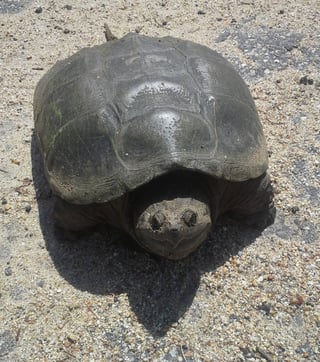This is a common snapping turtle. It's not a tortoise. The biggest difference is that turtles are aquatic, spending most of their time in the water, while tortoises live on land.
As for your other questions:
Age:
It's not easy to tell the age of the snapper. They reach full size between 8 and 10 years old. Adults measure from 9.5 to 14.5 inches (24 to 36 cm), with many growing much larger. Healthy snappers live an average of 40-60 years, sometimes longer. By that criteria, the one in your pictures looks fully grown, and is probably somewhere between 10 and 60!
Diet:
Snappers are omnivores. About two-thirds of their diet is plant-based, including all aquatic vegetation. They also eat insects, spiders, worms, fish, frogs, grubs, smaller breeds of turtles. When bigger they eat snakes, birds, and small mammals. They're pretty sedentary, grabbing what comes by rather than hunting.
Nesting habits:
Size, rather than age, determines maturity. Breeding begins at about 8 inches long, usually about 6 years old. They nest between April and November. They mate in the water, then the female travels many days and more than a mile, without stopping for water, to make the nest. (Interestingly, fertilization can take place up to two years before she lays the eggs!) Nests are built on land, in loose, sandy soil, on hills, in full sun. She lays a "clutch" of 20-50 eggs, covers them, and makes the long journey home. If she likes the nesting spot, she'll use it for many years. It's called "nest site fidelity."
Eggs incubate two to four months, depending mostly on the weather. Sadly, very few snapper births are successful, some sources estimate as low as 1 in 100, thus the need for the large clutch. Birds and animals eat most of the eggs. Of those that survive, few hatchlings make it to adulthood. However, large snappers have very few animal predators. Their primary predators are humans, so if they can steer clear of us, they can live a long time!
Best place and time to see them:
In the spring and the fall, the female is seen during the day, traveling to and from nesting areas. Unfortunately, those sightings are usually in the road, where they risk "death-by-car"! They're hard to spot in their murky waters, but they're nocturnal, and eat after dark and early in the morning, so that's the best time to see them. Even then, they stay underwater much of the time, with just their neck and head sticking up, so look for eyes or a moving head. Tread lightly. If scared they'll go under water and swim quickly away.
Conservation status:
In most areas where snappers are abundant, they're not classified as "endangered." In Massachusetts they're "protected." It's illegal to hunt, capture, or remove one from its habitat. Handling is illegal too, and subject to fines, although sometimes people will do so to help them cross the road. Picking them up incorrectly is extremely dangerous to them and should always be avoided unless there's really no other choice. Special handling permits are given to certified wildlife rescuers, rehabilitators, and treatment centers. Even after dying, they're an important part of the eco-system. Removing dead body parts, including just the shells, are subject to a fine, as high as $500.00. In Massachusetts, the penalty for breeding and sales is as high as $2,000.00 (They're legal to have as pets in some states, but not in Massachusetts.)
Some interesting facts:
- The temperature at which the eggs are maintained determines the gender. Eggs maintained at 68°F produce only females; those at 70-72°F produce both male and female turtles; and those incubated at 73-75°F produce only males.
- Snapping turtles have extremely good eyesight both above and under water. They can even see straight above their heads. They also have excellent hearing.
- Because of their bone structure, snapping turtles can't retract their neck all the way into their body, like most other turtles can.
- Snappers don't bask on rocks or logs. They get the light they need by raising their head toward the sun while the body is underwater. If you think you see a "snapping turtle" on a log, it's probably a different, but similar-looking, turtle. Full-grown snappers are too big for most logs anyway!
- Snapping turtles are not as aggressive as commonly believed. They will only defend themselves if cornered, cut off from water or physically handled. They don't like confrontation, and would rather swim away than attack.
Information sources include, but aren't limited to:
Tortoise Trust
Bio-kids
Massachusetts Department of Energy and Environmental Affairs
State of Connecticut Department of Energy and Environmental Protection
Tufts Wildlife Center
Incredible World



